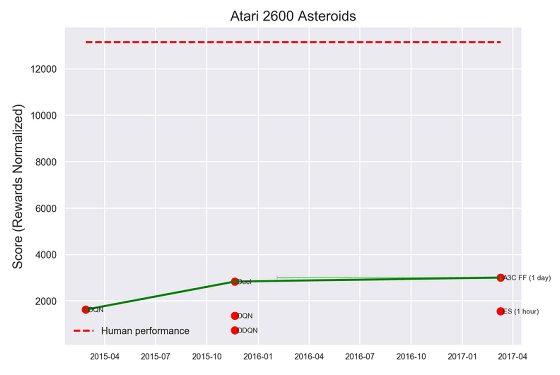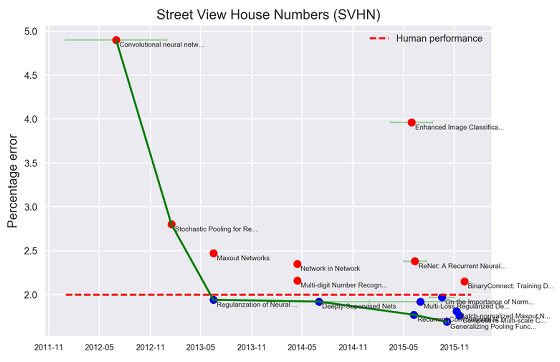A graph showing how artificial intelligence (AI) has overtaken humans and overtaking them is like this

What is the relationship between artificial intelligence and human ability? Therefore, the Electronic Frontier Foundation (EFF) graphs how much the ability of artificial intelligence catches up with human ability in games, image recognition, languages, and other categories. Looking at the graph, it is already evident that artificial intelligence is already overtaking humans, things that still have a difference, things that will be overtaken a little later.
AI Progress Measurement | Electronic Frontier Foundation
https://www.eff.org/ai/metrics
A comparison between artificial intelligence and human ability is "Game Playing (game)" "Vision and image modeling" "Written Language" "Spoken language" "Scientific and Technical Capabilities , "Learning to Learn Better" (learning for efficient learning), "Safety and Security (safety and security)" classification.
So, one example of the graph is as follows.
Firstly from "Game Playing (Game)". The graph of the development of artificial intelligence chess ability is shown below, the vertical axis isIloratingResults, horizontal axis shows the age. The red dotted line shows 2882 points, as a result of human being "playing the best." In the graph, in 2006 the chess engine "Rybka"Overtaking human capabilities by recording 2995 points.

There is also a comparison of human capabilities with various kinds of Atari games, and it is very interesting that it is clearly known whether or not you overtake humans by games. For example, Atari 2600 Amidar did not reach human ability in 978 points in DQN test conducted in 2015, but 1793 points in Double DQN (DDQN) test, architecture with Dueling Network implemented in DDQN Then it is 2354 points, far exceeding the ability of human beings.

On the other hand, Atari 2600 Asteroids, as of 2017, the graph does not reach the red dotted line showing human capabilities.

Atari 2600 Q * Bert has human performance of 13455 points, DDQN has reached 14875 points in October 2015.

"Vision and image modeling" compared artificial intelligence with human image recognition capability. Where the vertical axis shows the error rate and the horizontal axis shows the age and the human error rate is 0.051, the artificial intelligence of Microsoft Research Asia (MSRA) reported an error rate of 0.03567 on December 10, 2015 I will.

Also, the graph showing the error rate using the data set of Google Maps's image recognition algorithm "Street View House Numbers (SVHN)" looks like this. Where human error rate is 2%, Regularization in Neural Networks records error rate below 2% in 2013.

Then "Spoken Language" category. Switchboard Hub 5 '00 The graph below shows how the error rate of speech recognition has changed in the benchmark. Baidu's "Deep Speech"Or"RNNLMAlthough the artificial intelligence such as "competitive" competes, the results are raised, where the human error rate is 5.9%, CNN - LSTM reached 5.9% in October 2016.

About the translation ability This graph compares artificial intelligence and humans. The vertical axis is the score of the BLEU score used for the quality evaluation of machine translation, the horizontal axis is the age, the human score is set to 50. As of 2017, although artificial intelligence has not reached human translation ability, it can be seen that accuracy has gradually increased.

The following is a graph comparing artificial intelligence and human reading comprehension. Although the bAbI dataset for testing the logical thinking power of artificial intelligence was used, artificial intelligence has not overtaken the 81.6% of human reading comprehension rate for children's books, It was announced in 2016Neural semantic encoders(NSE) had one head protruding.

Related Posts:
in Science, Posted by darkhorse_log






